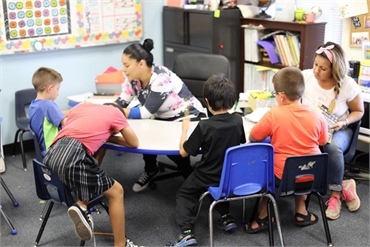What is the Best Learning Environment for a Child with Autism

In our world of standardized testing, routine management, and group focused instruction, it can be difficult to find a true learning environment. However, there are several benefits to a more relaxed learning atmosphere. The first benefit of such an environment is that children learn much better when they are allowed to slow down and absorb the information at their own pace. If a teacher is constantly prompting a child to move or do something that they are uncomfortable doing, the learning environment will likely discourage such behaviors. The result may be that the child loses interest in the lessons altogether.
Social Interaction
Many of today's high schools and colleges offer courses that are highly structured and heavily regulated. Students are required to follow specific instructions and often perform multiple tasks within a short period of time. Within these controlled environments, students often feel hemmed in and unable to roam freely. These controlled settings often deter students from participating in meaningful social interaction. The result is that social skills that would normally develop through family, friends, and peer interaction are often delayed or even lost altogether. This can have an enormous impact on a child's emotional development.
Best Learning Environment for a Child
While some autistic individuals may find academic success within the walls of a traditional classroom, most autistic students excel in an experiential learning environment. Such learning environments provide an environment where students can explore new interests, work independently, and experiment with novel approaches to learning. The result is an education that doesn't rely heavily on a teacher's instruction but allows a student to self-discover, and implement his or her preferred method of learning. This type of educational experience also allows for greater self-awareness and self-management of behavior. In short, it fosters a sense of self-confidence and self-direction in an individual who might otherwise feel shy, introverted, or even fearful within the classroom.
Education with Autism
Many autism education experts believe that the best learning environment for a child with autism school is an environment that combines a range of different types of stimulation. This means that while a child is in a controlled environment, he or she is also exposed to a wide variety of experiences outside of the classroom. For example, in the home, parents can engage their children in conversation-based activities such as story time, one-on-one time with peers, or even family games like hide and seek.
Best Learning Environment
While a controlled setting is important for many children with disabilities, many autistic people prefer an "in the know" learning environment. After all, if they can learn without the constant supervision of a teacher or other adults, then why can't they learn in the same way at home? With this type of learning environment, there may be no set curriculum; there are no set times for lessons or activities. In some cases, parents and teachers may work together to create a program that fits the individual needs of the child.
Social Skills
While most children with autism do well with a controlled environment, some seem to respond better to an "experiential" environment-one that allows them to explore and learn on their own. For these children, music therapy or art therapy may be the right choice. Many autistic individuals enjoy being able to express themselves through music or art; these opportunities allow them to learn independently and to be in control of their learning.
In the case of children with autism, the best environments are those that foster independence. These environments should not be ones in which the child feels dependent upon other people. These children often need more time with their families and are often best suited for social skills and group activities.
Last Words:
With appropriate supports, routines and structure, most children with autism manage to thrive. The best learning environment for a child with autism can vary based on the child's needs. The more a child knows his or her teacher, the more able he or she will be to learn independently. In the case of music or art therapy, the child must also be able to participate willingly.

